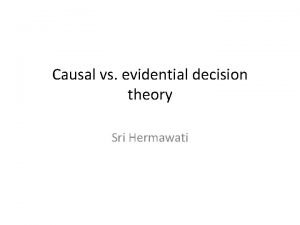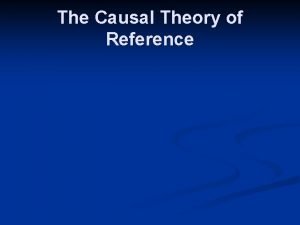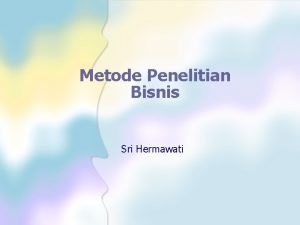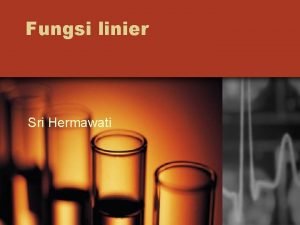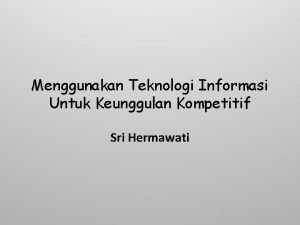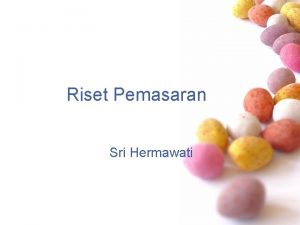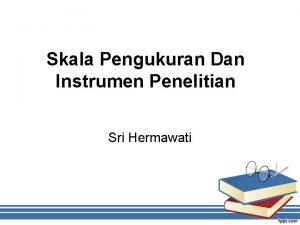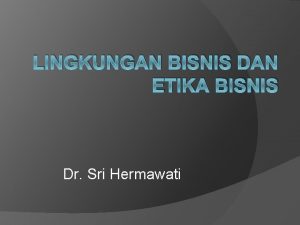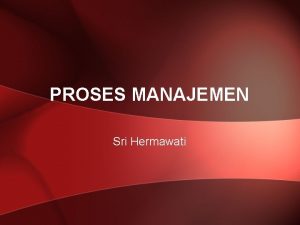Causal vs evidential decision theory Sri Hermawati The










- Slides: 10

Causal vs. evidential decision theory Sri Hermawati

• The focus of this chapter is on the role of causal processes in decision making.

Newcombs problem/ the predictors paradox • You are offered a choice between two boxes, B 1 and B 2. Box B 1 contains $1, 000 and you know this, because it is transparent and you can actually see the money inside. Box B 2 contains either a million dollars or nothing. This box is not transparent, so you cannot see its content. You are now invited to make a choice between the following pair of alternatives: You either take what is in both boxes, or take only what is in the second box. You are told that the predictor will put $1 M in box B 2 if and only if she predicts that you will take just box B 2, and nothing in it otherwise. The predictor knows that you know this. Thus, in summary, the situation is as follows. First the being makes her prediction, then she puts either $1 M or nothing in the second box, according to her prediction, and then you make your choice. What should you do?

Newcombs problem Alternative 1: Take box B 1 ($1, 000) and box B 2 (either $0 or $1 M). Alternative 2 Take only box B 2 (either $0 or $1 M). Second box contains $1 M Second box is empty Take second box $1 M (prob. 0. 99) $0 (prob. 0. 01) only Take both boxes $1 M + $1, 000 (prob. 0. 01) $1, 000 (prob. 0. 99)

• To keep things simple, we assume that your utility of money is linear • the expected utility of taking only the second box is as follows: Take box 2: 0. 99 · u($1 M) + 0. 01 ·u($0) = 0. 99 · 1, 000 + 0. 01 · 0 = 990, 000. • However, the expected utility of taking both boxes is much lower: Take box 1 and 2: 0. 01 · u($1 M) + 0. 99 · u($0) = 0. 01 · 1, 000 + 0. 99 · 0 = 10, 000. • Clearly, since 990, 000 > 10, 000, the principle of maximising expected utility tells you that it is rational to only take the second box.

Causal decision theory • causal decision theory is the view that a rational decision maker should keep all her beliefs about causal processes fixed in the decision-making process, and always choose an alternative that is optimal according to these beliefs.

Causal decision theory Gene No gene Read Section 9. 2 Pass exam & miserable life Pass exam & normal life Stop at Section 9. 1 Fail exam & miserable life Fail exam & normal life • Naturally, causal decision theory recommends you to take two boxes. Since you know that the predictor has already placed or not placed $1 M in the second box, it would be a mistake to think that the decision you make now could somehow affect the probability of finding $1 M in the second box. • The causal structure of the world is forward-looking, and completely insensitive to past events.

Causal decision theory leads to reasonable conclusions in many similar examples. For instance, imagine that there is some genetic defect that is known to cause both lung cancer and the drive to smoke, contrary to what most scientists currently believe. However, if this new piece of knowledge were to be added to a smokers body of beliefs, then the belief that a very high proportion of all smokers suffer from lung cancer should not prevent a causal decision theorist from starting to smoke, because: (i) one either has that genetic defect or not, and (ii) there is a small enjoyment associated with smoking, and (iii) the probability of lung cancer is not affected by ones choice. This conclusion depends heavily on a somewhat odd assumption about the causal structure of the world, but there seems to be nothing wrong with the underlying logic.

Evidential decision theory • Paul is debating whether to press the kill all psychopaths button. It would, he thinks, be much better to live in a world with no psychopaths. Unfortunately, Paul is quite confident that only a psychopath would press such a button. Paul very strongly prefers living in a world with psychopaths to dying. Should Paul press the button? (Egan 2007: 97)

According to the causal decision theorist, the expected utilities of the two alternatives can thus be calculated as follows. • Press button: p(press button □→dead) · u(dead) + p(press button□→ live in a world without psychopaths) · u (live in a world without psychopaths) = (0. 001 · − 100) +(0. 999 · 1) = 0. 899 Do not press button: • p(do not press button □→ live in a world with psychopaths) · u (live in a world with psychopaths = 1· 0 = 0

